Static Site Generators (SSGs) are tools that help you automatically build static HTML web pages from input files, such as templates, content, and configuration code.
The idea behind this approach goes way back to the early days of web development, particularly with the use of early systems such as HSC (HTML Sucks Completely), created by Thomas Aglassinger in 1996. HSC was developed to simplify the process of maintaining multi-page HTML sites by introducing features that make code reusable, like includes and macros. Having said that, it was never widely adopted or recognized as a mainstream part of web development.
Static Site Generators gained renewed attention in 2008 with the creation of Jekyll, a Ruby-based SSG developed by Tom Preston-Werner (the co-founder of GitHub). As time and technology advanced, more modern SSGs were introduced to the industry, including Hugo, Gatsby, Next.js, and more.
These technologies have increased in popularity in recent years within modern web development. In fact, according to Whalesync, more than 35% of the top one million sites now utilize an SSG due to its impressive speed, stronger security, and more straightforward scalability.
In this article, we will cover what Static Site Generators (SSGs) are, their pros and cons, popular examples, how to choose the right one, and common misconceptions users often have about them.
Defining Static Site

A static site is a collection of web pages made with HTML, CSS, and JavaScript. These pages are kept on a server and sent directly to a user's browser.
You can think of a static website like a digital brochure, as the content is always displayed when someone visits. When a user accesses the site, their web browser sends a request to the web server, which responds with a prebuilt HTML file that looks identical for every visitor.
In contrast, a dynamic website build process is always on the fly at the moment a user makes a request. This process relies on server-side languages such as PHP, Ruby, or Python, and content management systems (CMS) like WordPress, Drupal, or Alchemy CMS, which pull data from databases to display real-time content.
A good example of a static site is a portfolio website or landing page built using only HTML, CSS, and JavaScript files. Whenever you visit these types of pages, the duplicate content, including text, images, and videos, is displayed with every request.
On the other hand, e-commerce websites, content management systems (CMSs), and enterprise applications are examples of dynamic sites. When a user sends a request to the server, the system interacts with databases, performs server-side rendering, and may even perform complex computations before returning the response. The content can change dynamically with each request, based on the user's request or the availability of new data at that time.
Defining Static Site Generator (SSG)

As mentioned earlier, a Static Site Generator (SSG) is an automation tool that can be used to create static HTML websites, speeding up the development process by utilizing raw data, configuration, and a set of templates.
Instead of manually coding individual HTML pages, static site generators provide methods to pre-build or create content and then compile it into static HTML files, ready for deployment to a web server. As a result, static sites load faster than traditional dynamic websites.
Static site generators streamline website development by automating everyday, repetitive tasks. This enables developers to quickly create layouts for static pages, link assets, and optimize code on the run.
A static site generator also ensures that all the code is consistent, avoids copy-paste code, and utilizes sophisticated programming logic, such as loops, conditionals, and partials, to build sites practically and efficiently.
In modern web development, a static website generator can be used to produce both static and dynamic websites. This is why hiring a website development agency for your project can give you an edge when working with modern web technologies, as they have reasonable experience in building both types of sites.
The Standard Static Site Generator (SSG) Workflow

A static website generator usually involves the following three standard workflows when producing static sites:
Phase 1: Content setup
In this phase, developers create and manage the website's resources.
This includes publishing posts or pages in plain text formats using Markdown (for blog entries or articles) or JSON/YAML (for structured data), along with SEO metadata like titles, descriptions, and tags.
Phase 2: Build process
Once the contents are configured, the static site generator can now process them through specific commands in the terminal to generate a completely static website
Typically, this produces a folder-like site, public or dist, that contains all the final HTML, CSS, JS, and image assets. The output website can also be previewed locally before deployment.
Phase 3: Deployment
This phase involves uploading the site's content to a web server, CDN, or hosting service, where you can finally view the website live and accessible through a web browser.
Pros and Cons of Static Site Generators
Like all other modern web technologies, static site generators come with their own strengths and limitations in both workflow and output.
Understanding these trade-offs is crucial in determining whether a static site generator (SSG) is the right choice for your website project.
Consider the table below.

Pros and cons of using static site generators in terms of security, scalability, performance, cost, reliability, version control, and collaboration. (Image Source)
Security advantages
As evident as it can be, static site generators create a set of files (HTML, CSS, JavaScript, and images) that can be served directly from a simple web server.
Static sites have substantial security advantages over dynamic websites because they don't rely on server-side technologies or database interactions. Since all pages are pre-rendered and served as static website files, they are simpler and present fewer vulnerabilities to malicious attacks or hacker exploitation, such as SQL injection and XSS attacks.
SSGs are usually secure to use, but adding features from outside sources through third-party tools might bring back the same security problems that static sites are designed to avoid if not done appropriately.
Scalability benefits
What most developers like about static site generators is that they produce highly scalable static sites. A static site generator ensures that each page is prebuilt and ready to be served through a typical web server or a Content Delivery Network (CDN).
This setup requires less computing power to handle sudden spikes in website traffic, as CDNs store copies of your site's files across hundreds of servers worldwide.
Nevertheless, static site generators can still encounter scalability issues during content updates, especially for large websites with hundreds or thousands of pages, as the entire site must be rebuilt and redeployed after any change.
Performance improvements
Because static site generators pre-render all pages, websites load almost instantly in users' browsers.
In fact, according to DreamHost, static websites can load 2–3 times faster than comparable dynamic sites, which is one of the key factors contributing to a higher ranking on Google's search engine.
When combined with browser caching and global CDN distribution, static site generators guarantee that every user, regardless of location, experiences the fastest possible load time. Having said this, as the website grows larger, updating or regenerating all pages after small changes can still slow down the development and deployment process, as mentioned earlier.
Cost and reliability
When compared to dynamic website development, static site generators provide a more affordable way to build websites.
Many providers offer free or low-cost plans for static sites, such as GitHub Pages or Cloudflare Pages, which are suitable for personal projects and small commercial websites.
Moreover, static site generators provide reliable uptime. No database might crash, no memory space issues, and no dependencies that can fail. If one server from a specific location experiences downtime, the CDN mirrors continue to deliver the website consistently.
Using static site generators may require extra tools or services from additional third parties to handle dynamic features, which could raise the overall cost of development beyond development control and Collaboration.
Static site generators can easily integrate workflows with version control systems such as Git-based platforms or other distributed repositories.
This means you can keep track of every change you make to your code and content, ensuring consistency and accuracy. This makes it easier for team members to work together.
Using a static site generator enables you to work on different features or pages of a website simultaneously through branches and merge requests. It also gives you the option to perform rollbacks. When a merging issue occurs, you can easily revert to a previous version of static sites with a single command.
The only drawback is that non-developers and beginners may find Git-based workflows challenging to use, which should also be taken into consideration.
Most Popular Static Site Generators
The Static Site Generator (SSG) ecosystem has grown impressively over the last few years.
Many developers are seeking ways to build websites that are faster, more secure, scalable, and easier to maintain without incurring significant costs. This makes static site generators an excellent solution for a wide range of projects, from personal blogs to complex applications.
To help you decide which one is best for you, let’s take a look at some of the top static site generators you can use.
1. Hugo
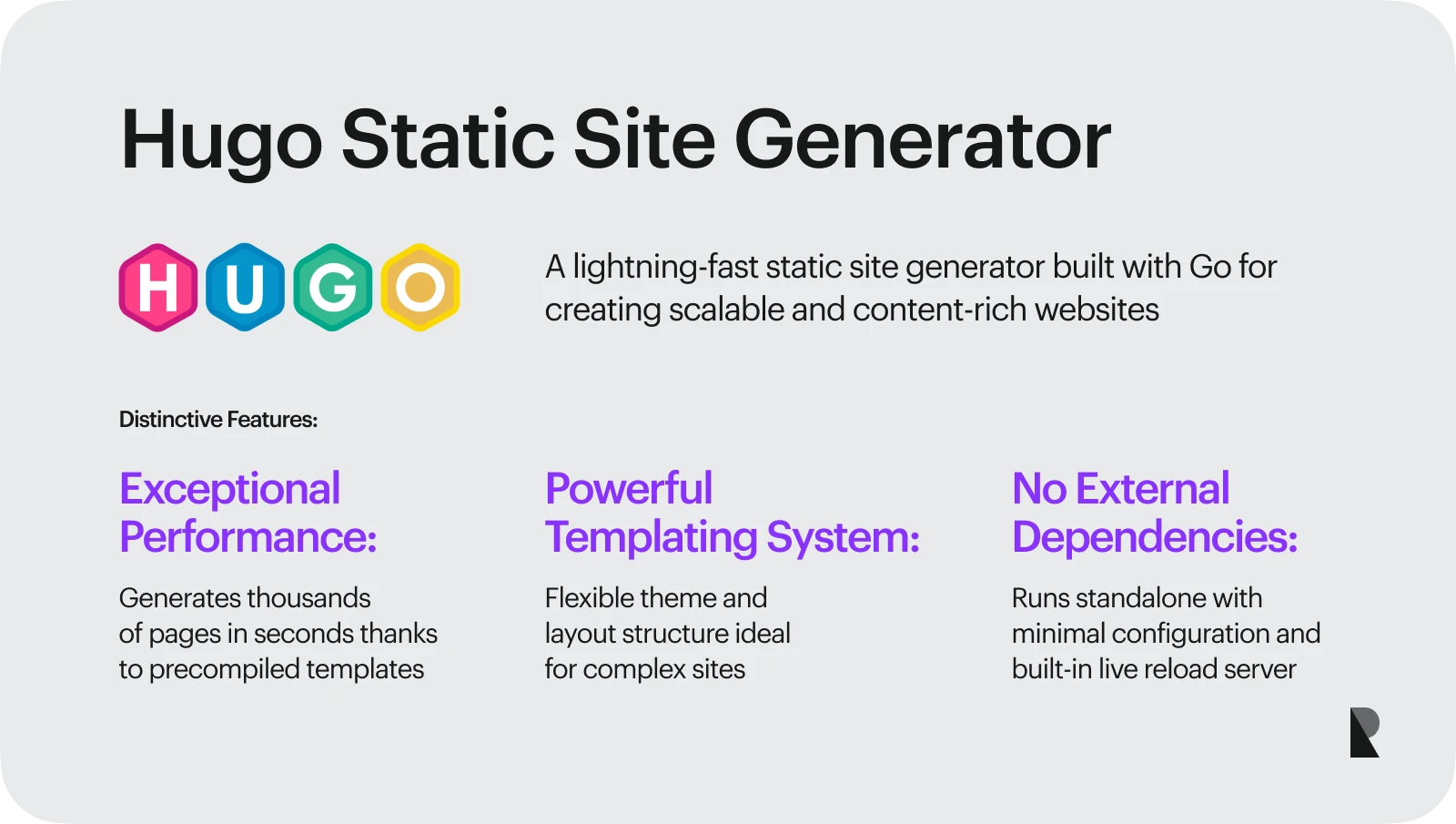
Written in the Go programming language, Hugo is one of the fastest static site generators available for developers who want to create lightning-fast static sites.
It is known for its outstanding build speeds and scalability with an extensive templating system. This makes it an excellent choice for content-heavy websites, such as documentation platforms and marketing sites.
Hugo doesn't need much configuration to get started, nor any external runtime dependencies. This static site generator precompiles templates, which allows it to generate thousands of static pages in just a few seconds.
It also supports shortcodes in Markdown, AsciiDoc, and other markup languages. It includes a live reload server for instant previews, making it an ideal static site generator for developers who value speed and simplicity.
2. Jekyll

Jekyll is one of the earliest and most popular modern static site generators, trusted by developers since its release in 2008. Written in the Ruby programming language, it’s widely known for its simplicity and beginner-friendly content structure.
Jekyll is one of the easiest static site generators to set up, which makes it also simple to host websites on GitHub Pages. Putting static sites online may be as easy as pushing them to a repository.
This is the best static site generator for developers who want a smooth, Git-based workflow without needing to set up complex configurations. It's great for personal projects, marketing websites, and even small online store sites.
Some of the standout features of Jekyll are that it uses Markdown and Liquid templating by default, and that it works with numerous plugins to add new capabilities. It can also be easily integrated with a headless CMS, allowing content editors to manage content without needing to learn coding.
3. Eleventy (11ty)
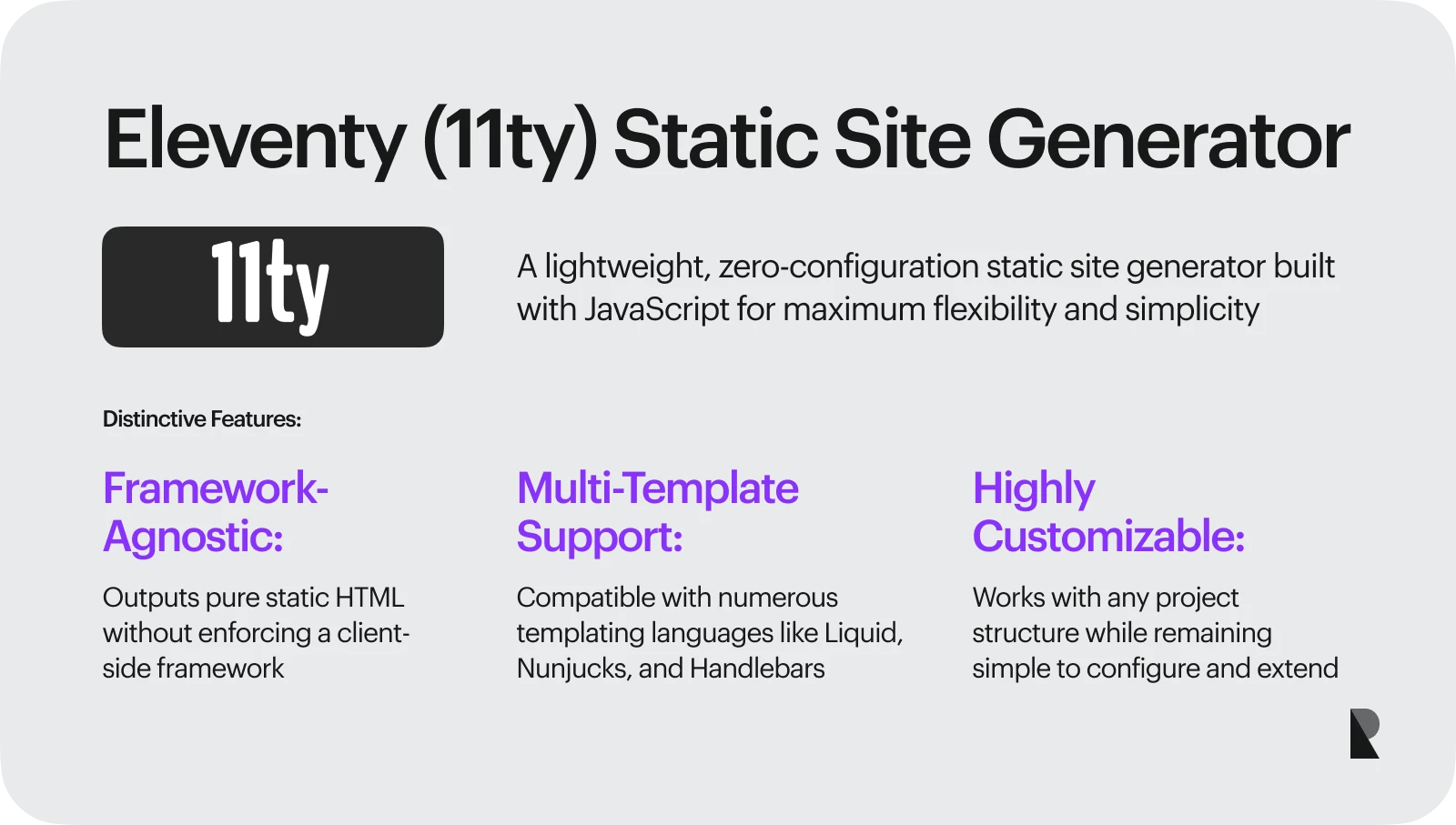
Eleventy (11ty) is a flexible and minimalist JavaScript-based static site generator designed as a simpler alternative to complex JavaScript frameworks.
It’s a zero-configuration tool out of the box but remains highly customizable. Eleventy works with almost any project structure and supports multiple templating languages, including Liquid, Nunjucks, Handlebars, and more.
Since its creation by Zach Leatherman in 2018, Eleventy has garnered a loyal following among developers seeking alternatives to JavaScript-heavy static site generators. It promotes no framework lock-in, as it can output pure static HTML without enforcing a client-side JavaScript framework.
Eleventy is one of the excellent static site generators to choose from for blogs, documentation sites, and small business websites, as it is easy to maintain and highly customizable.
4. Gatsby.js
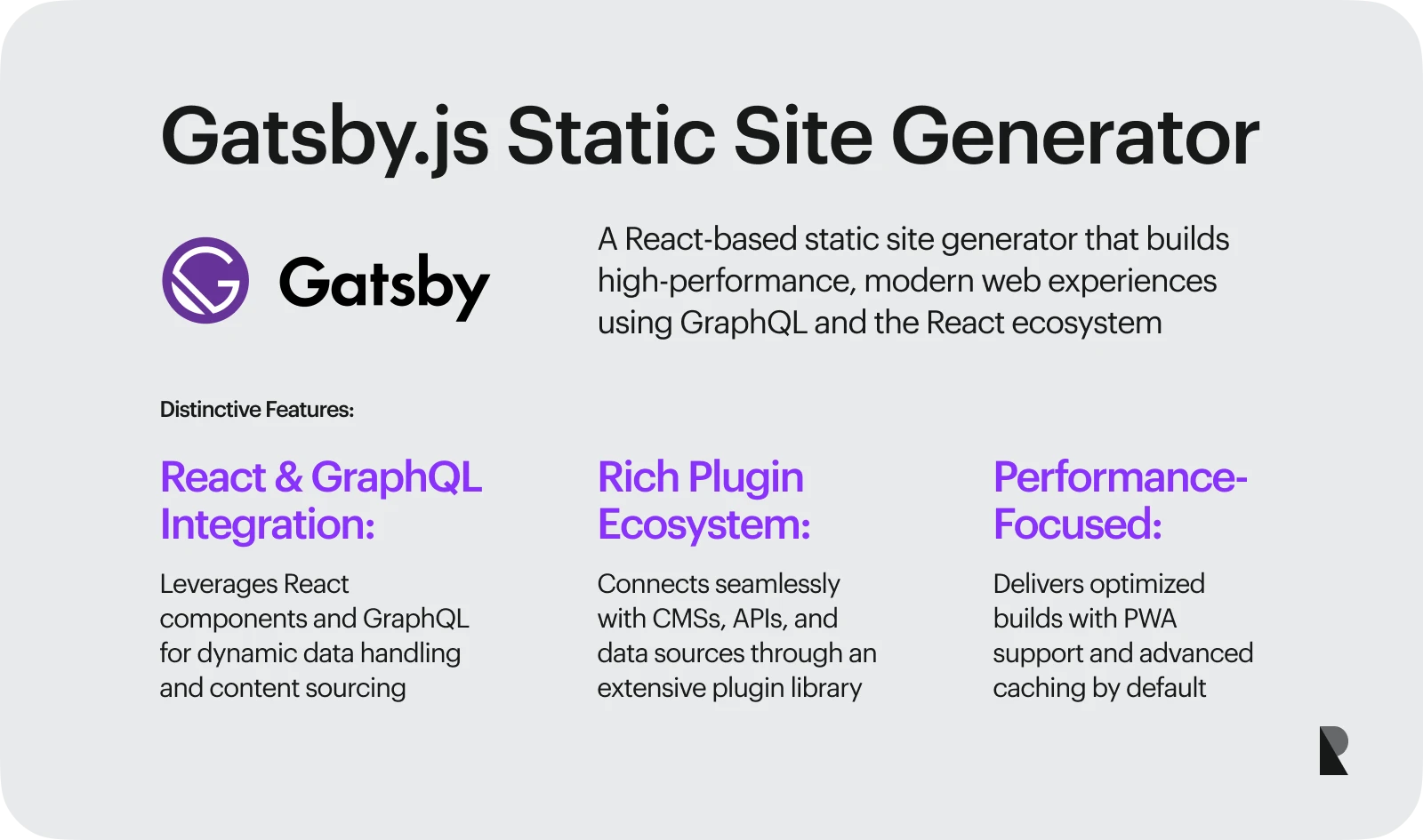
Gatsby has become one of the go-to static site generators for developers who want to build fast, React-based websites.
It originally started as a project by Kyle Matthews, who later teamed up with Sam Bhagwat to launch the company. In 2023, Netlify acquired Gatsby, providing it with additional support and closer integration with the Netlify platform.
Gatsby utilizes the React ecosystem and Webpack to produce static sites with modern development patterns, such as JSX, components, and hooks, by default. It also utilizes GraphQL to source and handle data during the build process, and then outputs static HTML, CSS, and JavaScript files from it.
While there are some opinionated views about using Gatsby as a static site generator, it’s still one of the best static site generator choices for most scenarios. In fact, it even has a rich plugin ecosystem that can pull in data from any source, whether it’s a headless CMS, API, or Markdown file. The best part of this static site generator is that it’s optimized out of the box for performance and can easily be configured as a Progressive Web App (PWA).
5. Next.js
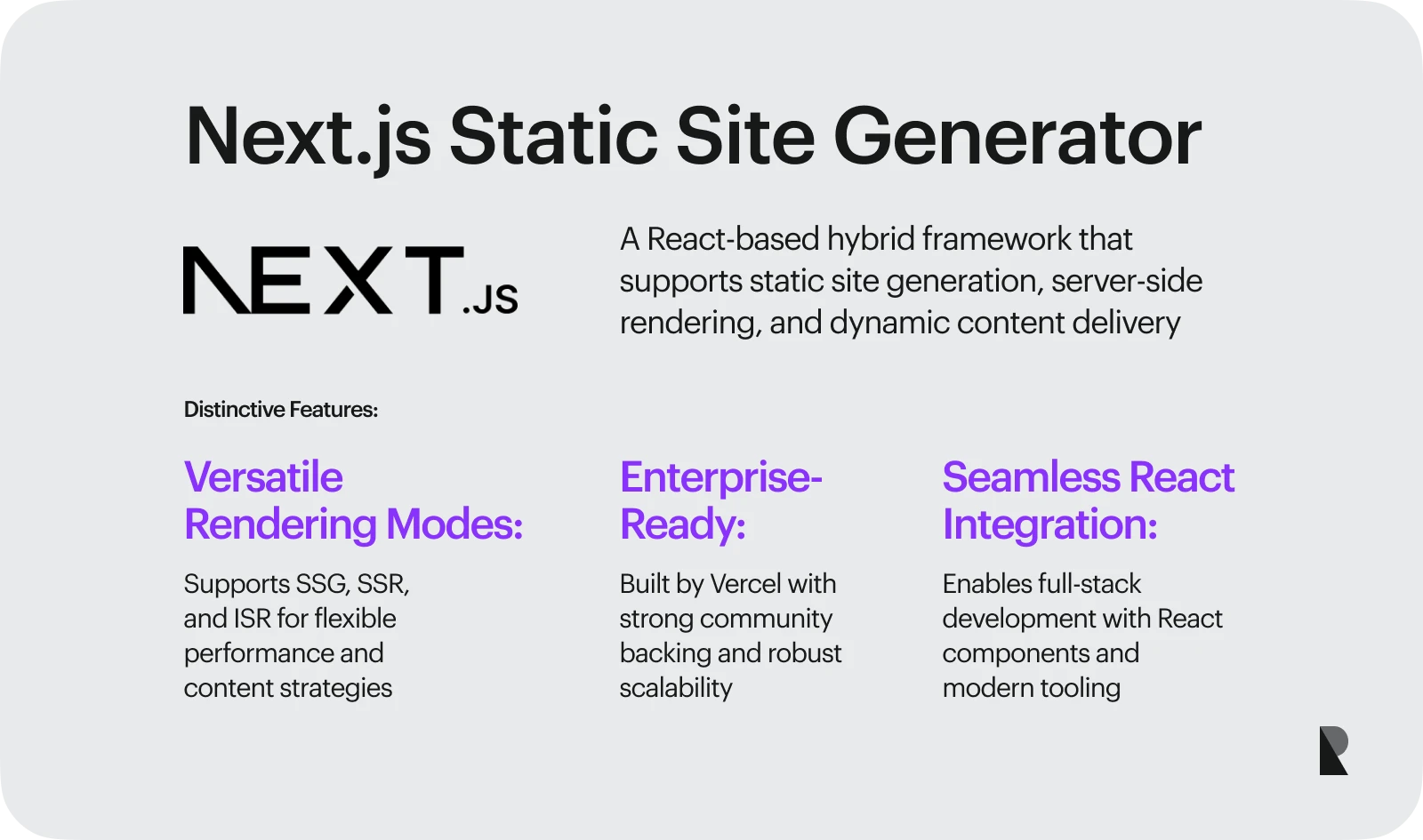
Next.js is a hybrid full-stack framework that does more than traditional static site generators can.
It was once made to provide a seamless universal JavaScript experience, but it has now grown into a top framework that supports several rendering modes, such as Static Site Generation (SSG), Server-Side Rendering (SSR), and Incremental Static Regeneration (ISR).
Because it was built and maintained by Vercel, it has a large community within the React ecosystem. Its tight integration with React makes it an ideal static site generator for many large enterprise applications and dynamic websites.
6. Nuxt.js
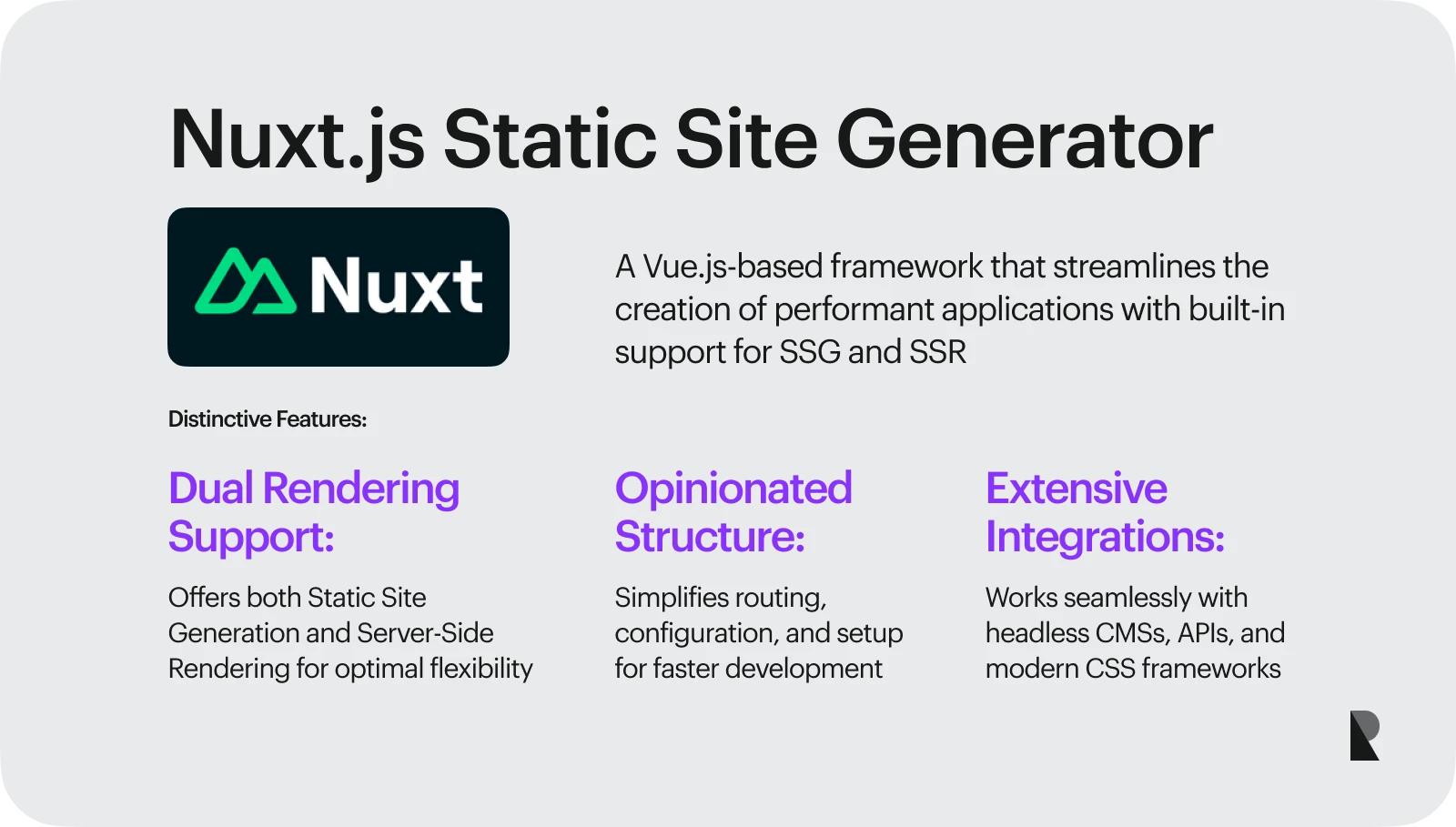
If Next.js is for React, then Nuxt.js is for Vue. It is a higher-level framework that makes it easier to build Vue apps by providing an opinionated structure and supporting both Static Site Generation (SSG) and Server-Side Rendering (SSR).
When it was first released in 2018, Nuxt.js was a lightweight static site generator that could only be used as a Vue CLI template. It has come a long way since it was just a simple static site generator. Now it runs on Node.js and is driven by Webpack and Babel under the hood. You can now also use Nuxt.js with headless CMSs, REST or GraphQL APIs, and other popular CSS frameworks.
Nuxt.js provides a solid framework that handles much of the setup, routing, and configuration work for you. This makes it easier to build feature-rich applications with Vue, especially for larger or more complex projects, such as e-commerce PWAs, content-heavy sites, or marketplace platforms.
How to Choose the Right Static Site Generator

While there’s no shortage of static site generators available online, choosing randomly from a list of static site generators is a big mistake without careful analysis and research.
Having said that, you can determine and gauge your static site generator options using a few simple, practical steps.
Step 1: Define the project type and requirements
As with any project, the first step in choosing the right static site generator is to identify the type of project you want to do and what it needs.
Begin by outlining your ideas and posing key questions. The following factors can help you create a clear plan for your project's SSG needs:
- Type of website (e.g., blog, documentation, marketing site, e-commerce)
- Expected traffic volume (monthly visitors or growth targets)
- Required features and integrations (e.g., real-time data, third-party tools, or API connections)
- Hosting environment (CDN-based, serverless, or custom static site generator infrastructure)
- Programming language support (some static site generators are built with Ruby, Go, etc.)
- Support and community (documentation quality, number of users, and activity level)
Note: If you’re new to using static site generators, consider hiring one of the best website design companies to handle the technical aspects and ensure a smooth development process.
Step 2: Match the static site generator to Your team and workflow
According to a study published on ScienceDirect, the tools a development team uses can have an impact on how well its members communicate, coordinate, and share knowledge.
This means choosing a static site generator that matches your team’s skills, knowledge, and tools can help everyone work together more efficiently and finish projects faster.
When choosing a static site generator, consider the following team-related factors to make an excellent and centralized decision:
- Technical expertise (tech stack, framework features, and language requirements)
- Learning curve (architecture, setup, and documentation)
- Workflow compatibility (team’s current processes, CI/CD, and collaboration style)
- Hosting and deployment options (hosting, CDN integration, and deployment automation)
- Plugin ecosystem support (community plugins, themes, and integrations)
- Version control support (Git-based workflows, branching, and collaborative versioning)
- Overall project goals (project scope, performance, and maintenance needs)
Step 3: Assess template and design complexity
While static site generators can automate the creation of websites, they differ in terms of template structure, style handling, and design complexity.
For instance, Hugo, Jekyll, and Eleventy use simple templating languages such as Liquid, Go Templates, or Nunjucks, which makes them ideal for beginners familiar with HTML and CSS.
On the other hand, static site generators or frameworks like Next.js, Gatsby, and Nuxt.js offer more advanced features, including component-based architecture, dynamic routing, and support for both client-side interactivity and server-side rendering.
Step 4: Check CMS and content workflow integrations
Many popular static site generators can scale and adapt as your project grows.
Some SSGs work seamlessly with Headless CMSs like Contentful, Strapi, or Sanity, as well as with Git-based CMSs such as Netlify CMS and Decap CMS. You can also incorporate them into content tools that support editorial workflows, live previews, and automated deployments.
To choose the best static site generator that fits your project, consider taking a closer look at the content workflow first to see how well each SSG works with it. It is also essential to understand how each handles media, webhooks, incremental builds, and build previews, as these factors significantly impact the performance and publishing speed of the websites.
Common Misconceptions About Static Site Generators (SSGs)
If you’ve been building websites for a while, you’ve probably come across various claims about what static site generators can and can’t do.
These myths circulate in online forums like Reddit, or Hacker News, which sometimes create confusion and misinterpretation.
So, let’s straighten up these myths, shall we?
Myth 1: Static site generators are only for blogs.
This myth is one of the most common misconceptions among users, especially beginners.
It's true that some static site generators, like Jekyll, became popular for blogging, several new tools like React, Vue.js, and Next.js are capable of much more. They support advanced page-building layouts, API connections, and CMS integrations, making them suitable for complex and large-scale websites.
To dispel the myth that static site generators are not suitable for production, many popular brands have successfully utilized them in their operations. For example, Sonos.com (built with Next.js), BackMarket.com (developed with Nuxt.js), and Kandji.io (built with Eleventy) demonstrate that these technologies can power a wide range of projects, from e-commerce and enterprise platforms to real estate and marketing sites.
Myth 2: Static sites can’t have dynamic features.
Just because SSGs produce static websites doesn’t mean they can’t have interactive or dynamic features.
To be more specific, modern static site generators like Gatsby, Next.js, and Nuxt.js let you add dynamic behavior using JavaScript, APIs, and client-side rendering. Many newbie developers think static site generators can’t really do these kinds of features.
For example, a static blog or website can have a comprehensive comment system built in, utilizing services like Disqus, Commento, or Hyvor. You can also use serverless functions, such as Netlify Forms or AWS Lambda, to handle forms, and tools like Auth0, Firebase Auth, or Google Identity to manage user authentication.
Myth 3: SSGs are hard to update, especially for non-developers
One of the common challenges when working with static site generators is keeping content updated while maintaining compatibility across framework versions and plugins.
This sometimes makes non-developers and content managers believe they must manually edit code or run command-line tools to publish updates.
When you use static site generators with headless or Git-based content management systems (CMSs), such as Contentful, Sanity, or Netlify CMS, it is usually considerably easier to update content. This setup allows content editors to update text, images, and pages using a visual editor, while leaving the detailed code work to developers, who maintain the site’s structure, design, and software dependencies.
Myth 4: Static means outdated or limited
While it’s called a "static," it doesn’t mean its capabilities are limited or outdated.
Modern SSGs empower websites with advanced functionality, including API integrations, client-side interactivity, and contemporary development workflows similar to those of full-blown web applications.

Wrapping Up: SSGs and the Future
Contrary to the belief that static site generators are only valid for simple or basic static websites, they are actually far more potent than many could think.
In recent years, SSGs have revolutionized modern web development, providing a compelling blend of performance, security, and developer experience, while also enabling developers to seamlessly integrate tools, APIs, and frameworks to suit their specific workflow.
Depending on your team’s skills, workflows, and goals, there’s always a static site generator that fits best for each project. That said, choosing the right one requires careful analysis and thoughtful evaluation.
Nov 5, 2025
